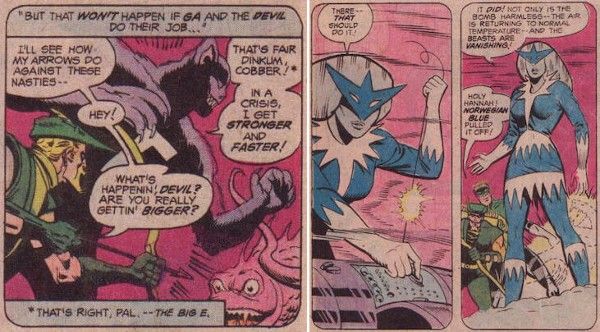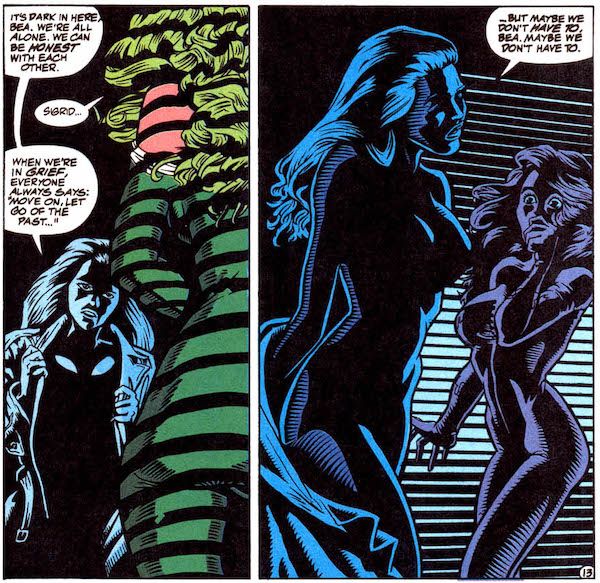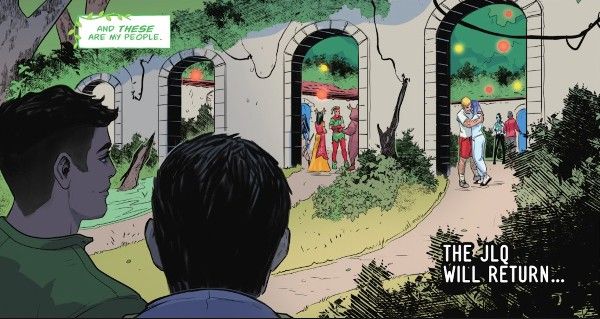In recent years, mainstream comics publishers like DC and Marvel have made great strides in increasing the LGBTQ+ rep in their universes, though they still have a long way to go. But getting here was a slow and gradual process, with many notable landmarks — and some admitted missteps — along the way. In Queer Superhero History, we’ll look at queer characters in mainstream superhero comics, in (roughly) chronological order, to see how the landscape of LGBTQ+ rep in the genre has changed over time. Today we’ll be looking at the first queer members of the Justice League: Tasmanian Devil and Icemaiden/Glacier!
Content Warning: Discussion of real-world child sexual abuse material (CSAM) and pedophilia.
Before I talk about the characters in today’s profile, I need to address a serious issue regarding one of the creators behind many of these comics. All of the comics involving Icemaiden’s time in the Justice League were written by Gerard Jones. Twenty years later, in 2016, Jones was arrested for possession and distribution of CSAM, a charge to which he pled guilty in 2018. According to Bleeding Cool, he served a little over four years of his six-year sentence before being released early, in December of 2022.
Icemaiden was and remains a groundbreaking character, and Jones’s Justice League comics are an important piece of queer comics history — not just for Icemaiden, as we’ll see, but for the way these comics began to explore the gender and sexuality of a number of characters on the team. There’s no denying that they helped pave the way for greater inclusion and diversity in the industry, and that should be celebrated. But it would be irresponsible to talk about these comics without disclosing Jones’s criminal record. It’s an unfortunate truth that part of studying the history of decades-old and still very much living franchises like DC and Marvel’s superhero universes is that sometimes important comics will be created by people who have done terrible things, and reconciling those facts is never simple or easy.
And speaking of reconciling facts: I shouldn’t even have to point this out, but Gerard Jones wrote groundbreaking comics with queer characters, and was jailed on CSAM charges, and those things have nothing to do with each other. We live in a moment where bigots are eager to fling baseless accusations of pedophilia at LGBTQ+ people in a desperate attempt to justify their bigotry. The fact that Jones (who as far as I’m aware is heterosexual) wrote some comics that were progressive for the time in regards to LGBTQ+ issues is completely unrelated to the nature of the charges against him, and frankly, the fact that that even needs to be said is appalling.
Okay. Now let’s talk about superheroes.
All of the characters I’ve covered so far on Queer Superhero History have been fairly obscure, but with today’s profiles, we are finally talking about that most lofty of superhero teams: the Justice League. And yes, okay, Tasmanian Devil and Glacier are not exactly household names. (Well, not DC’s Tasmanian Devil.) But they were still on the Justice League, and during a time when the League seemed much more open to queer identities than it had ever been before — or since, honestly.
Both of these characters first debuted in Super Friends #9 (December 1977) by E. Nelson Bridwell and Ramona Fradon. As the title suggests, this was actually a tie-in comic to the Super Friends animated show and wasn’t part of the mainstream DC universe. Taz and Icemaiden appeared in a storyline in which the Justice League teamed up with various international superheroes, ranging from “mildly cringey national stereotypes” to “extremely cringey national stereotypes.”
 |
In the late ’80s, these stereotypes were folded into mainstream DC continuity as a team called the Global Guardians, who mostly served as supporting characters to the Justice League International. The JLI was a fan-favorite iteration of the League that started in 1987, beloved for character-driven humor and zany shenanigans, though by the mid-’90s, it was very much past its prime. It was made up of a cluster of overlapping titles, including Justice League Quarterly, an extra-long book that came out — you guessed it! — four times a year.
Tasmanian Devil, AKA Hugh Dawkins, is basically a were-Tasmanian devil. He appeared sporadically across various JLI titles for a few years, but he was little more than furry muscle until Justice League Quarterly #8 (Autumn 1992). In a story written by Kevin Dooley and drawn by Andy Smith, Hugh mentions being gay in a conversation with some other Guardians.
 |
To add some context to this 31-year-old panel, homophobia in Tasmania was particularly virulent in the early ‘90s, sparking protests against widespread police harassment and abuse. It was around this time that the Tasmanian Parliament rejected a bill to decriminalize homosexuality, and Tasmanian LGBTQI+ activists actually went to the UN to apply international pressure. I’m guessing that’s what Dooley had in mind when he wrote Hugh’s line about some places being hateful, and it’s likely that many readers would have understood it in that light. That context, I’d argue, reframes this very quiet outing of a very minor character as a political statement, and one that would have resonated with queer readers, particularly Tasmanian ones. (Homosexuality was not decriminalized in Tasmania until 1997.) It’s also a pointed step forward for Dooley after the awkward tangle he got himself into talking about Extraño in letter columns just three years prior.
Unfortunately, although Hugh then went on to be a member of Justice League International (second volume) for its entire 18-issue run, his sexuality is never referenced except very obliquely. Of course, being gay shouldn’t be the entirety of his character, but to relegate it to a single solitary panel is disappointing, to say the least.
After the JLI disbanded, Hugh spent the next decade or so as an occasionally-seen Z-lister. When he finally showed up in comics again in a significant way…it was only part of him. In 2009’s widely reviled Justice League: Cry for Justice, it was revealed that the villain Prometheus had skinned Hugh and turned him into a rug. Luckily, a one-off issue of Starman/Congorilla two years later revealed that somehow this hadn’t killed him and he was fine now??? There were a lot of talking gorillas involved. I can’t explain it any more coherently than that, I’m sorry.
Glacier was also introduced in Super Friends #9, using the codename Icemaiden (sometimes rendered as Ice Maiden) and she/her pronouns. We were given little information about them besides the fact that they were Norwegian, they had ice powers, and they had blue skin. An entry in Who’s Who in the DC Universe (1985-1987) revealed that their name was Sigrid Nansen.
A few years later, Green Flame (Beatriz da Costa) and Icemaiden of the Global Guardians joined the Justice League International. The two close friends soon changed their codenames to the matching “Fire and Ice,” and were mainstays of the team for many years. But this Icemaiden was named Tora Olafsdotter, and she did not have blue skin.
The mystery (well, the continuity error) wasn’t solved until after Tora died in battle in 1994. A “new” Icemaiden appeared: Sigrid, who explained that they had been the original Icemaiden on the Global Guardians, but had stepped aside when Tora appeared because Tora was so much more powerful than they were (Sigrid’s powers were the result of a science experiment, while Tora is a literal ice goddess). Now they had returned to the League to honor the fallen Tora — specifically the branch featured in Justice League America, which wound up being about as queer as a mainstream comic could get in 1996.
Bea, Tora’s grieving best friend, immediately latched on to Sigrid, trying to replicate the intensely codependent friendship she’d lost. Sigrid went along with it for a while, but the queer subtext finally came to a head in Justice League America #103, when Sigrid confronts a distraught Bea.
In an intensely — and deliberately — homoerotic scene, Sigrid strips down to reveal Tora’s costume (!) and coaxes Bea to confess what she’s been hiding — what she really wants. Bea confesses that she’s always been confused and “afraid of being punished,” and Sigrid offers to be Tora for her if that’s what Bea needs. All the while, the lighting in the scene plays with what we’re allowed to see — is Sigrid wearing Tora’s costume or nothing at all? Is their skin blue or white?
 |
Bea ultimately makes the healthy choice — to reject what Sigrid is offering in favor of treating Sigrid like their own person and not a replacement for her dead friend — which is what Sigrid wanted.
But this sequence isn’t just about titillation (though let’s be honest, that’s a big part of it). Shortly afterward, Sigrid’s teammate Nuklon asks them out, telling them that he thinks they have a lot in common. Sigrid agrees: “We both like girls.”
Nuklon is confused because Sigrid has dated men before. Sigrid agrees that they are attracted to men and women, with a preference for women, but they reject the term “bisexual,” or any other label. Nuklon asks what’s going on with them and Bea, and Sigrid says Bea is still figuring some things out. Later, Bea admits that she’s still confused, but acknowledges that her feelings for Tora were more intense than for any man. (As of 2023, Tora has been back from the dead since 2007, and yet she and Bea are still doing the queerbaiting dance. It’s exhausting.)
 |
I mentioned earlier that this era of Justice League America was about as queer as a mainstream comic could get in 1996. Aside from Sigrid being canonically queer and Bea being clearly questioning, this lineup also has Obsidian, who didn’t come out until 2006 and so will be getting his own article further down the line, but there’s a strong case to be made for considering him canonically queer this early — he is very obviously, explicitly in love with his best friend Nuklon, and like Sigrid, refuses to put any labels on his sexuality, including “straight.” (Rejecting labels is obviously a valid choice, but having both Sigrid and Obsidian do it in back to back issues is a bit annoying, since it’s also very much a ’90s-era media stereotype for bisexual characters.) Oh, and the team lineup also includes an alien character called the Yazz, who uses non-gendered pronouns because they are the last of their race and wish to represent all of their people.
And yes, all of these characters are incredibly obscure, I know. I am very aware that the Yazz is not going to be appearing in a major feature film anytime soon. But Sigrid coming out was groundbreaking on its own. Taken as a whole, the overall queerness of the book is even more remarkable — especially when you consider that there wouldn’t be a queer character on any version of the Justice League again until 2009 — and that was the aforementioned deeply reviled Justice League: Cry for Justice lineup, which barely counts.
The JLI, in all of its branches, was disbanded soon after Sigrid came out, and like Hugh, Sigrid was relegated to occasional cameos for years and years. And like Hugh, they came to a gruesome, ignominious end of a sort in JSA: Classified #19-20, when it was revealed that their “alabaster” skin (another continuity error — remember, Sigrid is blue) had been surgically removed to be worn by a villain obsessed with being beautiful. Sigrid somehow survived this process but ended up comatose in a hydration tank at STAR Labs. It’s very, very weird that both queer members of the Global Guardians had their skins stolen but didn’t die. Also, I hate this.
Basically every former Global Guardian was erased by the New 52, but Hugh finally reappeared in 2017’s Midnighter and Apollo #6, where it was revealed that he is now married to Extraño, DC’s first out superhero, and they live in Lima with their daughter. I love this as much as I hate the skin-stealing thing, which is to say: a lot.
Since then, Gregorio and Hugh have become mentors and elder statesmen to some of DC’s younger queer characters (sometimes semi-officially referred to as the JLQ). They were most recently seen in this role in 2021’s ‘Tis the Season to Be Freezin’, which also brought Sigrid back to the DCU.
In a story by Andrew Wheeler and Meghan Hetrick, Sigrid is captured by a villain called Minister Blizzard, who has in some unexplained way rescued them from the STAR Labs hydration tank, and plans to use their power to bring eternal winter, starting by attacking the JLQ. Sigrid is lost, feeling mistreated and abandoned by the people who tried to change them — they namedrop Bea and Nuklon here — but a young magician named Syl manages to reach out to them with compassion, helping them to break Minister Blizzard’s control. Sigrid announces that they are defining themself from now on, and that their new codename is Glacier. The final page of the story uses they/them pronouns for Sigrid, and Wheeler confirmed on Twitter that Sigrid is nonbinary.
 |
Again, Tasmanian Devil and Glacier are not exactly flagship Justice League members — but they were Justice League members, during a time when DC was clearly becoming more comfortable making statements in solidarity with LGBTQ+ rights movements and letting numerous characters question and reconsider their sexualities. That was a big step forward, and it was lovely to see Hugh and Sigrid getting to hug it out all these years later — forgotten for a while, yes, but not forever. DC has promised that the JLQ will return, and I for one look forward to seeing them — and seeing Hugh and Sigrid happy and comfortable in their (not stolen) skins.
 |
Source : Queer Superhero History: Queering the Justice League










